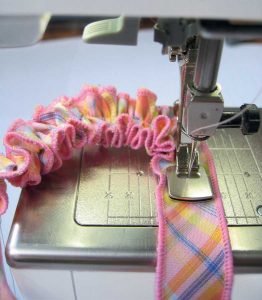We love sharing stories from ASG chapters!
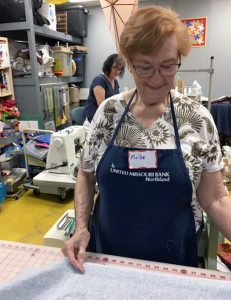 This wonderful article came to us from the Kansas City chapter. It offers inspiration and shows, once again, how generous ASG members are with their knowledge and time.
This wonderful article came to us from the Kansas City chapter. It offers inspiration and shows, once again, how generous ASG members are with their knowledge and time.
The Kansas City North Neighborhood group found a great audience for teaching sewing at the North Kansas City library. With funding help from the Rotarians, the NKC library had created a maker space with a dozen sewing machines, cutting tables, irons and cabinets of fabrics and other supplies. After one of our members, Barb Lea, started teaching a bimonthly quilting class at the library, group leader Jan Letkowski had the idea that teaching others to sew would be a challenging and worthwhile endeavor in addition to our efforts of sewing quilts and other items for charity.
In the spring of 2019, Jan, Melba Nicolaisen and Phyllis Carlyle visited Amy Brown, director of programming at the library. The library had been teaching projects twice a month, plus offering open sewing times and Amy was thrilled to learn that skilled sewists were interested in outreach education to their patrons. We were happy to see a well-equipped space with quality Janome machines, Oliso irons, task lamps and a box of tools at each sewing machine.
Getting Started
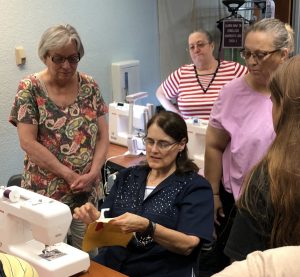 We initially committed to teaching three classes, July through September. Each class would be taught by a team to involve as many of our members as possible.
We initially committed to teaching three classes, July through September. Each class would be taught by a team to involve as many of our members as possible.
Phyllis Carlyle volunteered to lead the first class on fused machine applique for clothing, accessories and home dec. Ten students showed up to hear about the materials and techniques for successful machine applique. With the assistance of Bonnie Anderson and Sandy Cahill, the students made test samples using provided patterns from a 4 page handout. It was gratifying to see some of the students go beyond the basics and at the end, director Amy Brown asked for the class to be taught again. We were so excited!
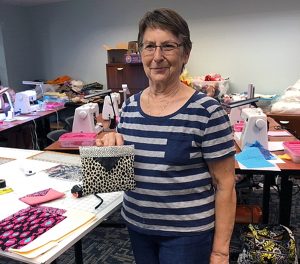 For the next class, Sharon Lair and Linda Gregg presented a workshop on making snap bags. Patrons enjoyed sewing these small bags using printed cottons and metal measuring tape pieces for the closure. It was a perfectly sized project for an evening class with lots of gifting possibilities.
For the next class, Sharon Lair and Linda Gregg presented a workshop on making snap bags. Patrons enjoyed sewing these small bags using printed cottons and metal measuring tape pieces for the closure. It was a perfectly sized project for an evening class with lots of gifting possibilities.
Then, in September, Jan Letkowski and Vicki Portwood presented a class on sewing basics: seam finishes, gathering techniques, making a perfect patch pockets, and learning to read patterns and follow instructions. Once again, attendees loved seeing samples of our favorite tools and supplies. This class was so popular, the participants begged Jan and Vicki to return so they took Holiday sewing projects to the open sewing session the following week.
Sewists Want to Sew
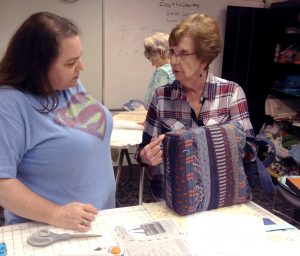 Library patrons at these sessions range from teens to seniors, mostly beginners, with a variety of sewing skills. For some, this is their only access to sewing machines. Our experience has shown that the patrons at the sessions WANT TO SEW! We are mixing in skill-building during each session, but find we need to take at least one project or sample for them to try. In addition, some of our members are attending the scheduled informal open sewing sessions to offer assistance to anyone who shows up.
Library patrons at these sessions range from teens to seniors, mostly beginners, with a variety of sewing skills. For some, this is their only access to sewing machines. Our experience has shown that the patrons at the sessions WANT TO SEW! We are mixing in skill-building during each session, but find we need to take at least one project or sample for them to try. In addition, some of our members are attending the scheduled informal open sewing sessions to offer assistance to anyone who shows up.
More Community Outreach
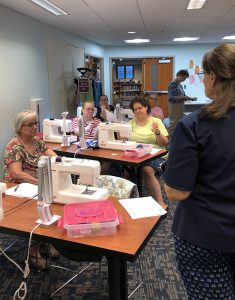 In addition to teaching at the library, the group also volunteers at The Sewing Lab, a non-profit community resource center providing classes and jobs training in sewing-related arts in the KC urban community. Melba Nicolaisen, Linda Gregg and Vicki Portwood have been assisting with teaching classes to immigrants. The students from the Don Bosco center are hard workers who are eager to learn and they appreciate our help. Manager, Linnca Stephens, loves having volunteers who relieve the class teacher of many mundane tasks such as problems with the machines so they can concentrate on instruction. There are many teaching, learning and donating opportunities all over and we encourage members to get involved in sharing the life skills and creativity of sewing that we love.
In addition to teaching at the library, the group also volunteers at The Sewing Lab, a non-profit community resource center providing classes and jobs training in sewing-related arts in the KC urban community. Melba Nicolaisen, Linda Gregg and Vicki Portwood have been assisting with teaching classes to immigrants. The students from the Don Bosco center are hard workers who are eager to learn and they appreciate our help. Manager, Linnca Stephens, loves having volunteers who relieve the class teacher of many mundane tasks such as problems with the machines so they can concentrate on instruction. There are many teaching, learning and donating opportunities all over and we encourage members to get involved in sharing the life skills and creativity of sewing that we love.
~Phyllis Carlyle, Kansas City Chapter of ASG





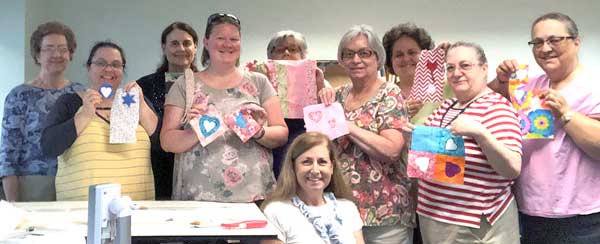
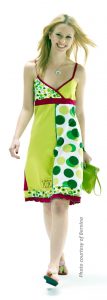
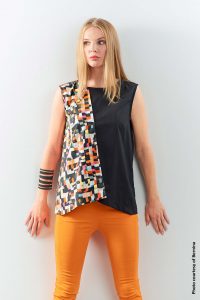
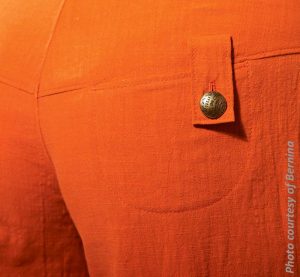

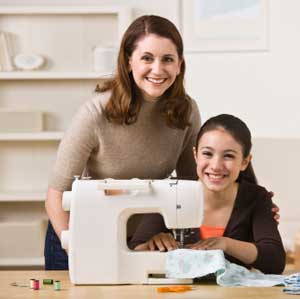 This story is by Hope Wright from ASG Springfield Lincolnland Chapter
This story is by Hope Wright from ASG Springfield Lincolnland Chapter